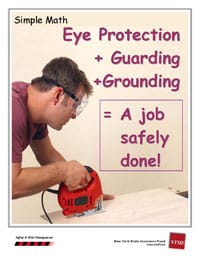Hand Tools
Hand tools are non-powered. They include anything from axes to wrenches. The greatest hazards posed by hand tools result from misuse and improper maintenance.
Hand Tool Misuse
- The greatest hazards posed by hand tools result from misuse and improper maintenance.

- Some examples:
- Using a screwdriver as a chisel may cause the tip of the screwdriver to break and fly, hitting the user or other employees.
- If a wooden handle on a tool such as a hammer or an axe is loose, splintered, or cracked, the head of the tool may fly off and strike the user or another worker.
- A wrench must not be used if its jaws are sprung, because it might slip.
- Impact tools such as chisels, wedges, or drift pins are unsafe if they have mushroomed heads. The heads might shatter on impact, sending sharp fragments flying.
Hand Tools
- The Students is responsible for the safe condition of tools and equipment used by employees but the employees have the responsibility for properly using and maintaining tools.
- Students should use caution when using saw blades, knives, or other tools that are to be directed away from aisle areas and other students working in close proximity. Knives and scissors must be sharp. Dull tools can be more hazardous than sharp ones.
- When using sharp tools; never make your cut strokes towards yourself always make your cuts away from your body and others.
Basic Hand Tool Safety Rules
- Around flammable substances, sparks produced by iron and steel hand tools can be a dangerous ignition source. Where this hazard exists, spark-resistant tools must be used.
Tips
- Wear Personal Protective Equipment (PPE) such as safety glasses, safety goggles, face shields, gloves and proper clothing as
 appropriate.
appropriate.
- Do not operate power tools without the instructor’s permission.
- Do not wear loose clothing or jewelry when operating power tools. Long hair must be tied back.
- Follow the manufacturer’s instructions for lubricating and changing tool accessories.
- Keep guards in place and follow lockout/tag-out procedures.
- Know the purpose of each tool you use, and use each for the specific task it was designed to do.
- Always use two hands on the tool when operating. Clamp work piece to a solid surface; do not attempt to hold work piece with hand or foot.
- Unless it’s designed for it, never use a portable electric tool where there are flammable vapors or gases present.
- Electrical cords must be in good condition; report any broken, damaged or bare cords. Keep cords away from heat, oil, and sharp edges
- All power tools must be effectively grounded and/or be of the double insulated type.
- If the tool is equipped with a three-prong plug, it should be plugged into a three-hold electrical receptacle. Never remove the third prong.
- Never use power tools in damp or wet locations or if the worker is perspiring. Moisture helps electricity flows more easily through the body.
- Rubber gloves and footwear are recommended when working outdoors in damp conditions.
- Never carry a tool by its cord, or pull the cord to disconnect it from a receptacle Never carry a plug-in tool with your finger on the switch.
- Unplug tools before replacing any broken, dull or damaged bits or blades.
- Be careful not to overreach. Keep your balance and proper footing when working with power tools.
- When you have completed an operation with a power tool, switch it off and lay the tool down in a safe manner after it stops. Keep the rotating blade or bit away from your legs and body.
- Keep floor around work area clean.
- Be sure the power switch for a portable tool is “off” before plugging it in.
